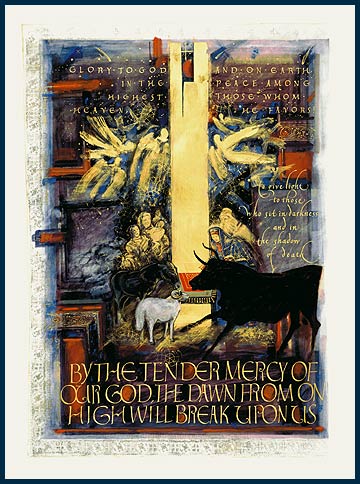

![]()
![]()

Luke frontispiece: The Birth of Christ
(Luke 2:1-20)
Donald Jackson
Natural hand-ground ink on calfskin vellum
Image copyright 2002 The Saint John's Bible and Saint John's University
Gold is used throughout The Saint John's Bible to indicate the divine. Here a brilliant shaft of light, executed in gold leaf, rises from the child's crib, making the Christ Child the focal point of this scene, although he is not pictured. His mother, Mary, gazes tenderly on the infant. The shepherds are women and girls, which was probably the case at the time of Christ. Between the viewer and the unseen infant, the animals form a protective barrier. The ox is modeled on one of the Neolithic cave paintings of great aurochs at Lascaux, France. In the well-known imagery of the Nativity, we see the coexistence of earthly, animal energy and spiritual energy, represented by the angels and the powerful light of God.
The upper text is the angels' song; the central text refers to this child's role as "light to those who sit in darkness"; and the lower text anchors the entire illumination in a metaphor of divine light.
Click on a page:

The Birth of Christ





